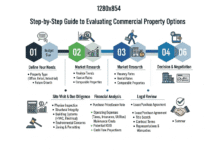Understanding property boundaries and ownership is crucial for real estate transactions, as it ensures clarity and facilitates smooth dealings within the industry. Parcel maps play an essential role in this process by offering detailed information about land features. They clearly illustrate property boundaries, dimensions, and other significant geographical elements that aid property transfer. This article discusses the importance of parcel maps and their impact on real estate transactions.
Importance of Parcel Maps
Parcel maps provide a comprehensive view of a parcel of property, showcasing boundaries, measurements, and surrounding landmarks. These maps are invaluable for buyers and sellers, offering insights into land divisions and helping resolve potential encroachments or disputes during ownership transitions. Clarifying a parcel’s size and characteristics ensures smoother property transactions.
Improving the Clarity of Properties
Parcel maps are essential in real estate transactions as they clearly outline property boundaries, reducing any uncertainties or confusion for buyers and sellers. Buyers gain reassurance from understanding the size and shape of the property they intend to purchase, while sellers can demonstrate transparency and integrity through these maps. This transparency fosters trust among all parties, facilitating more effective negotiation processes.
Assisting in the Process of Identifying Easements
Granting others usage rights on a property through easements can complicate real estate transactions. Parcel maps are essential for identifying these easements and understanding their impact on land use. A clear understanding of these rights is necessary to avoid conflicts and facilitate negotiations that consider the interests of all parties involved.
Engaging in Ensuring Zoning Adherence
Zoning laws control how properties are used in different areas. Accurate maps of land parcels are essential, as they outline the boundaries and permitted activities within specific zones. Property owners can refer to these maps to understand what uses are allowed on their land, helping them avoid potential issues and fines. Additionally, investors and developers use these maps to assess the feasibility of their projects and ensure compliance with community regulations.
Supporting Environmental Considerations
Conducting evaluations is crucial for ensuring that sustainable property development practices are followed diligently in today’s industry. Parcel maps play an important role by providing essential information about natural elements such as wetlands, flood zones, and protected regions.
By understanding and acknowledging these factors, individuals involved in property development can make informed decisions that prioritize environmental preservation and work to reduce negative impacts on ecosystems. Presenting this data through parcel maps encourages responsible development approaches aimed at safeguarding our precious natural resources for the benefit of future generations.
Helping with Dividing Land into Plots
Dividing land into sections requires careful planning, and accurate measurements are essential for success. Maps of the parcels help guide the process by ensuring that the division complies with local rules and regulations. These maps also assist in identifying potential challenges, such as irregular shapes or access issues that may arise during the division process. By anticipating these obstacles, developers can take proactive steps to address them, ultimately streamlining the land division process and enhancing the property’s value.
Streamlining the Evaluation of Taxation
Real estate taxes are an essential consideration for property owners. Parcel maps simplify the assessment process for tax authorities by providing detailed information about properties. Accurate mapping ensures that taxes are based on actual property measurements and features, which helps reduce disputes over tax payments. This transparency enhances the efficiency of real estate tax procedures. Additionally, reliable parcel data assists property owners in effectively planning their budgets and finances.
Promoting Making Informed Choices
Real estate deals require commitments and rely heavily on well-thought-out decision-making processes for success. Field maps provide essential details that enable buyers, sellers, and investors to make informed decisions. With access to precise information regarding property sizes, boundaries, and characteristics, stakeholders can effectively evaluate potential risks and benefits. This knowledge fosters meaningful conversations, leading to choices that align with individual objectives and desires.
Summary
Parcel maps are essential in property transactions as they provide clarity and accuracy, making complex processes more straightforward. They help define property boundaries, identify easements, and ensure compliance with zoning regulations. Additionally, these maps assist in planning, land division, and tax evaluation. By facilitating informed decisions, parcel maps contribute to smooth and effective real estate transactions. Recognizing the importance of parcel maps in property dealings benefits everyone involved by promoting transparency and trust.





